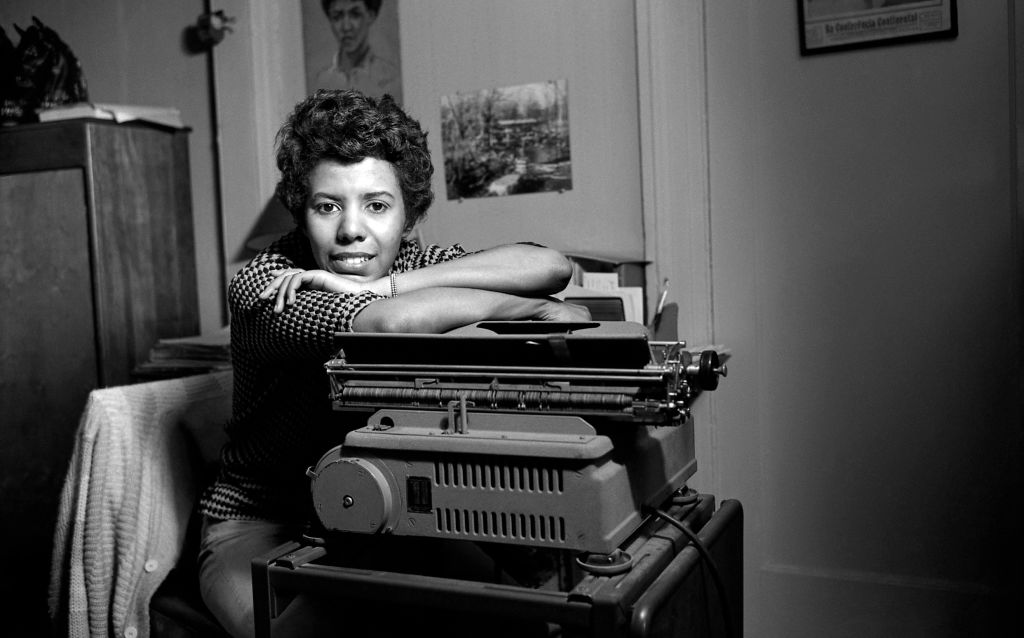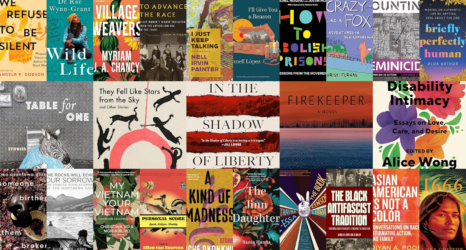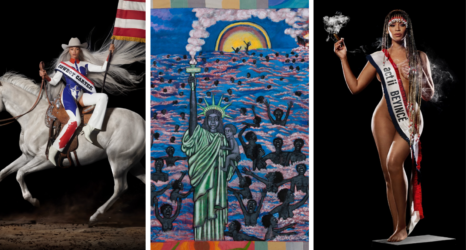
Black History and Women’s History Months are coming to a close, but we must keep celebrating Black women’s genius as a daily feminist practice. Projects like Christen Smith’s “Cite Black Women” do this work in the academic sphere, but there are so many other spaces of influence that get overlooked. The theatre world is one of them.
I recently had the honor of seeing the Brooklyn Academy of Music’s production of Lorraine Hansberry’s The Sign in Sidney Brustein’s Window, accompanied by a photo exhibit about the author. Hansberry is best known for A Raisin in the Sun (1957), the first production written by a Black woman staged on Broadway, which won her a New York Drama Circle Critics Award in 1959. When Hansberry was 29, Raisin was also nominated for a Tony award for best play. Raisin’s critical success extolled her virtuosity—the mastery of recording Blackness from all angles, its technical, sonic, affective, corporeal effects in seamless technique.
As a playwright who intimately knew the subject of African American Chicago where she grew up, Hansberry’s positionality also made her an exception, at times a token figure in the theatre world, only as an interpreter of early 20th century Black life in urban spaces. When Imani Perry said of Hansberry, “Static things don’t breathe. Or live. But Lorraine did. Deeply,” she identifies why her larger-than-life Black feminist internationalist artwork and short life had a “pruning device” taken to them.
The 2023 BAM revival of The Sign in Sidney Brustein’s Window centralizes Hansberry’s life as closeted lesbian metaphorically and her interracial marriage with fellow Jewish communist activist and publisher Robert Nemiroff. Up until this revival, critics of the play argued that Hansberry was coloring outside the lines as a Black author, instead of discussing real-life influences and a notion of relational Blackness. Interviews and critics’ coverage assume the play was sidelined in her oeuvre because the principal characters are not Black. Yet, her life-long experience of observing white people as a DuBoisian, pan-Africanist communist activist married to a Jewish man is the value added to the play. As people of color, we spend our entire lives observing white normativity, and to pigeonhole Hansberry as exclusively a recorder of Black urban life is a grave error.

Black characters in Sign are secondary. Yet Blackness haunts the text with the constant specter of 15-year-old bar attendant “junkie” Will Johnson’s drug overdose—and when characters Alton Scales (Julian Henry De Niro) and Max (Raphael Nash Thompson), a beatnik artist, are part of Sidney and Iris’ Greenwich Village progressive bubble. Hansberry turns the microscope on this world with searing, caustic dialogue that cuts and burns with racial slurs and gendered putdowns that simply do not fly in the contemporary political landscape’s cancel culture.
When their comrade Alton falls in love with Iris’ sister, Gloria, and wants to marry her, Sidney and Iris do not disclose that Gloria is a prostitute. Instead, they encourage Alton to believe in Gloria’s marriageability and focus on the potential social mobility their light-skinned African American comrade could gain in turn.
In a soliloquy after Alton finds out that Sidney has lied by omission that Gloria is a prostitute, he rebuts the racist reality check delivered about the sexual politics of marrying a fallen white woman: “They used her like a thing like they used my grandmother like a thing when she was a slave. My grandmother was being used as a commodity. … I don’t want the white man’s leavings.”
His rage and trauma are generational, grappling with his enslaved grandmother’s rape and lack of control over her body and sexuality, and not equivocating when Sidney says that Gloria should be forgiven.
Even Gloria, when she realizes Alton will no longer marry her, uses a litany of racial slurs to defame her intended’s Blackness, to injure and mask the pain of being rejected by a Black man’s morality, as if he didn’t have a right to be righteous. Sidney asks Alton, “Is it because of the rising call of equality for your people that makes it impossible? Isn’t love of a woman enough?” To contemporary observers, the “your people” phrase marks a political and racial gulf between the progressive Jewish Sidney and Black Alton, that cannot be remedied. The sexual politics of Alton marrying a fallen white woman are trumped by his renewed pledge to pan-Africanism and Black civil rights struggles.
With a frenetic pace like that of Albee’s Who’s Afraid of Virginia Woolf, the BAM Sign revival mocks and parodies white boho self-righteousness. The caricatures of white liberalism coupled with racism—when Sidney plays the banjo like a hill person, stomping and then breaking into a stereotypical generic Indian war chant straight out of a western for his Greek-Cherokee wife Iris to recapture her sense of self and talent—had to be annoying to Hansberry, especially when taken up by lefty political types that were the descendants of European immigrants, ethnic whites or white-adjacent during the 1940s.
According to David Roediger, race was, in the late 19th and early 20th centuries, lodged in “pursuit of white identity, consistently tied to competition for wage labor and to political citizenship, [which] was largely coded as male, and it tended to apply awkwardly to the immigrant mothers whom both Americanizers and immigrant leaders.”
Sidney Brustein, a Jewish American activist and publisher—along with Wally O’Dell, an Irish American politician, who beats the machine only to be in cahoots with the machine—represent how assimilation means acquiring privilege and partaking in corruption or moral vacuousness.
Sidney has enough money to be a publisher and activist while Iris works at a diner as a waitress. Her recurring trauma emerges when Sidney “picks at her,” triggering a flood of memories of the sexual harassment she experienced in casting for the musical South Pacific. Iris is no immigrant mother, and Sidney is no Anglo American, and yet, their boho philosophical waxing about inequality of the “N***o” (Hansberry’s word, not mine) or Iris’ self-discovery and desire for independence from Sidney via psycho-analysis, the sexually charged word plays and flirtations with their gay playwright neighbor David ultimately expose that they all have double standards about who deserves political freedom and when. Even Iris’ self-righteous sister as a normative housewife type turns out to be quite complex, as does their baby-sister-turned-escort Gloria, who only appears in the last few scenes of the play.
As a Latinx feminist scholar concerned about anti-Blackness in our community, it’s also important to comment on Oscar Isaac’s (Scenes from a Marriage, Hamlet, Star Wars) role playing the Jewish radical Sidney Brustein. Portraying an at times misogynist, clearly alcoholic intellectual, Isaac was asked by the NYT what he thought of the role as a non-Jewish man. But I would also argue that Sidney’s hard-drinking, talking ulcer “lonely reckonings,” are Lorraine, and that Sidney is a composite of she and Robert Nemiroff. Hansberry, like Sidney, used alcohol to self medicate for depression and pain.
The question carried double significance considering the George Santos’ “I said I was Jew-ish, not Jewish” comments. Isaac pushed past the question to highlight Hansberry as a Black queer young woman.
While the response might be unsatisfying to proponents of ethnic authenticity casting, centralizing Black womanhood and Hansberry’s work speaks to anti-racist praxis by one of the most visible Latinx actors in Hollywood. As a Cuban Guatemalan cis-het man, Issac reminds us of how violent systems of racial exclusion have entrenched sexuality and racism in relationship to Blackness.
As Jennifer Loubriel has pointed out, “Even though you can be marginalized because you are Latinx, that does not erase the systemic white privilege you have because of your race.” I read Isaac’s response in this vein—taking responsibility for Latinx anti-Black racism by making us pay attention to Hansberry, the author, not his racial embodiment. Yet seeing Sidney flirt with, touch and be intimate with his comrades, wife and sisters-in-law demonstrate a kind of sexual fluidity that Hansberry imagined but could not practice until much later in life, as Imani Perry notes. Even if those transgressions were permissible for the cis-het Sidney, they still take place amongst and between men and women in what I have described as “emotional and sexual force that is unbounded by the discipline of institutions … because emotion was the ultimate anti-capitalist expression because it did not have material value in the marketplace.”
To bohemians, communists and anarchists with whom Hansberry and her husband Nemiroff communed, the play’s heightened emotional excess and physicality of emotion in that excess gets worked out most judiciously. The full dramatic weight of how oppressed groups reproduce structural racism and gender inequality while they politically agitated for civil and political rights are voiced by sisters Mavis, Iris and Gloria. Set in the boho village, the play’s intensive 2.5-hour dialogue frenetically exposes the failures of heteronormative coupling within progressive and boho spaces in New York City.
I heard two elderly white patrons during intermission say that the play was too long, and the director should have cut it. I was offended by the remark. It’s easy to suggest we trim for expediency, but not the words of a Black woman whose life was cut short by pancreatic cancer at the age of 35. We owe Lorraine Hansberry that much—to make visible what she saw, what she dreamed, and what she recorded as a keen preceptor of human fragility where desire, slurs and emotions swing like a pendulum. By staying true to the text in the BAM revival, we saw Hansberry’s keen wit, sardonic edginess, word-smithery and Black feminist critiques of patriarchy that made me smile and shiver simultaneously.
Up next:
U.S. democracy is at a dangerous inflection point—from the demise of abortion rights, to a lack of pay equity and parental leave, to skyrocketing maternal mortality, and attacks on trans health. Left unchecked, these crises will lead to wider gaps in political participation and representation. For 50 years, Ms. has been forging feminist journalism—reporting, rebelling and truth-telling from the front-lines, championing the Equal Rights Amendment, and centering the stories of those most impacted. With all that’s at stake for equality, we are redoubling our commitment for the next 50 years. In turn, we need your help, Support Ms. today with a donation—any amount that is meaningful to you. For as little as $5 each month, you’ll receive the print magazine along with our e-newsletters, action alerts, and invitations to Ms. Studios events and podcasts. We are grateful for your loyalty and ferocity.





